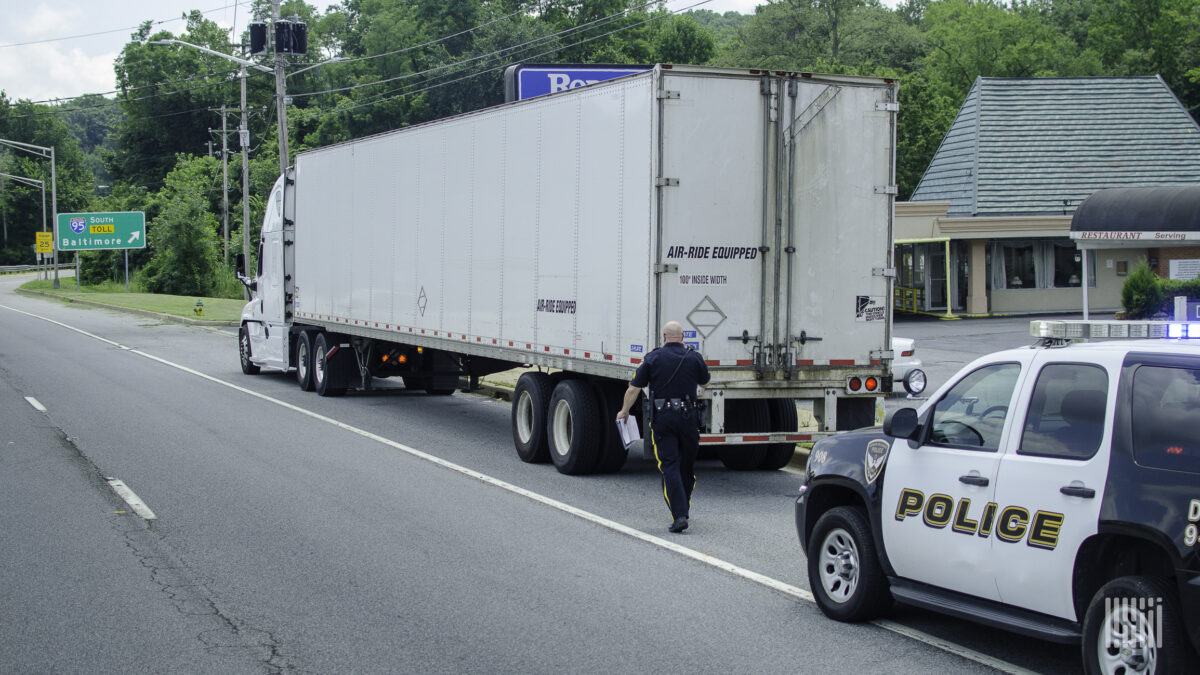Copyright FreightWaves

States would be required to verify lawful status of non-domiciled CDL applicants, not just residency in the state issuing the license. Applicants with Employment Authorization Documents (EADs), DACA status, asylum seekers, refugees or other non-permanent statuses might be excluded from eligibility under the bill’s definition. States would need to ensure license expiration aligns with immigration or work authorization expiration. States must maintain enhanced records and report non-domiciled CDL data to the Secretary of Transportation. The bill builds on the Federal Motor Carrier Safety Administration’s “Restoring Integrity to the Issuance of Non-Domiciled CDLs” interim final rule, codifying many of those provisions into law. In practical terms, this means the pool of drivers eligible for non-domiciled CDLs will shrink and the compliance burden on states, carriers and licensing agencies will increase. Why OOIDA Supports the Bill OOIDA has publicly backed H.R. 5688. Their leadership argues that the trucking industry’s problems aren’t driven by too few drivers, but by under-trained, improperly credentialed drivers entering the workforce. Their rationale: When licensing standards are lax, everyone pays — insurance costs go up, safety risks increase, and compliant carriers get squeezed. More stringent rules level the playing field, ensuring only drivers who meet defined eligibility get behind the wheel of a CDL rig. For small fleets and owner-operators who already compete on margin, this legislation promises fewer “bad actors” undercutting rates and driving costs up. OOIDA frames the bill not as anti-immigrant, but pro-safety and pro-business standards for truckers who are following the rules. Why Some Oppose It Critics of H.R. 5688 (and the interim rule on non-domiciled CDLs) raise several concerns: Driver Enforcement Loophole: At a time when capacity is at it’s highest, some argue that this will continue to allow the flow of unvetted as well as unqualified drives into the pool. Equity issues: Others argue the bill disproportionately affects drivers lawfully present in the U.S. but without permanent residency, potentially costing them livelihoods without clear evidence of increased safety risk. Implementation burden: Licensing agencies and carriers face more paperwork, verification steps and potential audits — small fleets may struggle to absorb the increased compliance cost. Lack of data: Some opponents claim the crash data linking non-domiciled CDLs and safety risk is insufficient to justify such a sweeping restriction. So for businesses that depend on every available CDL driver to keep trucks moving, the bill raises operational and commercial questions. Key Notes In The Bill 1. “States issuing commercial driver’s licenses to non-domiciled individuals” “To amend title 49, United States Code, with respect to requirements for States issuing commercial driver’s licenses to non-domiciled individuals.”Takeaway: This is a key point of the bill. It means the law is targeting CDLs issued to drivers who don’t legally live (domicile) in the state issuing the license. 2. Verification of lawful status The summary states that an applicant must “have lawful immigration status in the United States” and that the issuing state must “verify their lawful immigration status before issuing the CDL.”Takeaway: This means that having a work authorization or a temporary visa may no longer be enough. If their status is temporary or undocumented, states could refuse to issue or renew a CDL under these rules. The United States Government, per uscis.gov, defines “lawful immigration status” as: Aliens in the United States who are considered to be in lawful immigration status generally include: Lawful permanent residents (LPR), including lawful temporary residents and conditional permanent residents; Nonimmigrants; Refugees; Asylees; Parolees; Aliens in temporary protected status (TPS); and Aliens lawfully present in the Commonwealth of the Northern Mariana Islands (CNMI) between November 28, 2009 and November 27, 2011 based on a valid, unexpired, and lawfully obtained period of stay that was CNMI-authorized prior to November 28, 2009 that remains valid on the date of adjustment application. Simply filing an application for an immigration benefit or having a pending benefit application generally does not put an applicant in a lawful immigration status.In general, once an immigrant benefit application is approved, an applicant is in lawful immigration status as of the date of the filing of the application. 3. Duration tied to authorized stay Summary explains: “…issued for a period of up to one year or until the expiration of their authorized stay in the U.S., whichever is shorter.” Takeaway: Say you hire a driver with a license that expires because of immigration/work status, you will face turnover risk. The CDL might need renewal sooner, meaning you’ll have to track that and cover potential downtime or training costs. 4. Record-keeping and data reporting by states “The state must keep records of issuance … for at least two years and provide such records to the Secretary of Transportation upon request.”Takeaway: This adds a compliance burden. States will have to maintain more detailed logs; may mean increased audits, and carriers will need to keep driver files detailed and ready. If your driver is non-domiciled, expect more paperwork. Q&A Section Q: When will H.R. 5688 take effect? A: The bill is currently in committee. It has to pass the House and Senate and be signed into law. Meanwhile, the FMCSA rule it mirrors is already in effect (as an interim final rule) while litigation plays out. Q: Does the bill ban all non-domiciled CDLs? A: No. It narrows eligibility. Certain categories of work authorization and visa status remain eligible. The bill targets those who lack lawful, verifiable status or do not meet domicile requirements. Q: Could it increase rates and reduce capacity? A: That is a possible outcome. If fewer drivers are eligible, capacity drops and rate pressure may rise — but the impact will vary by market, lane and carrier. Final Thought H.R. 5688 isn’t just a bill headline—it’s a real-world piece of legislation that could reshape the driver pool, compliance demands and operational dynamics of every trucking business in America. Whether you’re running one truck or fifty, you’ll want to know where you stand. The decision now isn’t about waiting until the law passes or fails— it’s about preparing now, educating yourself, and positioning your business to adapt. Because when regulatory change hits, the carriers who react early are the ones who thrive, not the ones caught off guard.



